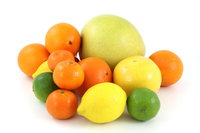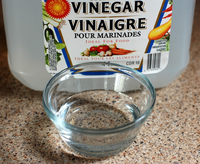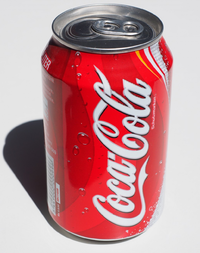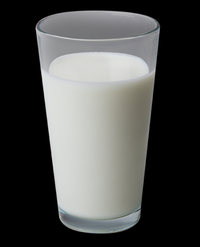Difference between revisions of "Acid"
(→Higher) |
(→About Acids) |
||
| (10 intermediate revisions by 2 users not shown) | |||
| Line 11: | Line 11: | ||
: When an [[acid]] is [[dissolve]]d in [[solution]] the [[Hydrogen]] [[atom]]s in the [[molecule]] become free to move around and these are what make it an [[acid]]. | : When an [[acid]] is [[dissolve]]d in [[solution]] the [[Hydrogen]] [[atom]]s in the [[molecule]] become free to move around and these are what make it an [[acid]]. | ||
: [[Acid]]s can be [[concentrated]] or [[dilute]]. | : [[Acid]]s can be [[concentrated]] or [[dilute]]. | ||
| − | : [[Acid]]s can be | + | : [[Acid]]s can be weak or strong which depends on the type of [[acid]]. |
: [[Acid]]s turn [[Litmus]] paper red. | : [[Acid]]s turn [[Litmus]] paper red. | ||
: [[Acid]]s turn [[Universal Indicator]] pink, red, orange or yellow depending on the strength of the [[acid]]. | : [[Acid]]s turn [[Universal Indicator]] pink, red, orange or yellow depending on the strength of the [[acid]]. | ||
Some common [[Acid]]s you should know: | Some common [[Acid]]s you should know: | ||
*[[Hydrochloric Acid]] - Found in the stomach. | *[[Hydrochloric Acid]] - Found in the stomach. | ||
| − | * | + | *Citric Acid - Found in [[Citrus]] fruits. |
*[[Ethanoic Acid]] - The common name for vinegar. | *[[Ethanoic Acid]] - The common name for vinegar. | ||
*[[Sulphuric Acid]] - Found in [[Electrical Cell]]s. | *[[Sulphuric Acid]] - Found in [[Electrical Cell]]s. | ||
| Line 28: | Line 28: | ||
|- | |- | ||
| style="height:20px; width:200px; text-align:center;" |Car [[Battery|batteries]] contain [[Sulphuric Acid]] at around [[pH]] 0. | | style="height:20px; width:200px; text-align:center;" |Car [[Battery|batteries]] contain [[Sulphuric Acid]] at around [[pH]] 0. | ||
| − | | style="height:20px; width:200px; text-align:center;" | | + | | style="height:20px; width:200px; text-align:center;" |Citrus [[fruit]]s have Citric Acid in them at around [[pH]] 2. |
| − | | style="height:20px; width:200px; text-align:center;" | | + | | style="height:20px; width:200px; text-align:center;" |Vinegar is made of [[Ethanoic Acid]] at around [[pH]] 2.5. |
|- | |- | ||
|[[File:Cola.png|center|200px]] | |[[File:Cola.png|center|200px]] | ||
| Line 35: | Line 35: | ||
|[[File:Milk.png|center|200px]] | |[[File:Milk.png|center|200px]] | ||
|- | |- | ||
| − | | style="height:20px; width:200px; text-align:center;" |Fizzy drinks contain | + | | style="height:20px; width:200px; text-align:center;" |Fizzy drinks contain Carbonic Acid at around [[pH]] 3. |
| style="height:20px; width:200px; text-align:center;" |Coffee is slightly [[Acid|acidic]] at [[pH]] 5. | | style="height:20px; width:200px; text-align:center;" |Coffee is slightly [[Acid|acidic]] at [[pH]] 5. | ||
| style="height:20px; width:200px; text-align:center;" |Milk has a small amount of [[Lactic Acid]] giving it [[pH]] 6.5. | | style="height:20px; width:200px; text-align:center;" |Milk has a small amount of [[Lactic Acid]] giving it [[pH]] 6.5. | ||
| Line 57: | Line 57: | ||
====Higher==== | ====Higher==== | ||
| − | : The [[concentration]] of an [[acid]] is determined by how many [[gram]]s of [[acid]] are [[dissolve]] per [[litre]] ([[decimetre cubed]]) of [[water]]. A [[dilute]] [[acid]] has very little [[compound]] [[dissolve]]d per [[litre]] while a [[concentration|concentrated]] [[acid]] has a large [[mass]] of [[compound]] [[dissolve]]d per [[litre]]. | + | : The [[concentration]] of an [[acid]] is determined by how many [[gram]]s of [[acid]] are [[dissolve]] per [[litre]] ([[Decimetres Cubed|decimetre cubed]]) of [[water]]. A [[dilute]] [[acid]] has very little [[compound]] [[dissolve]]d per [[litre]] while a [[concentration|concentrated]] [[acid]] has a large [[mass]] of [[compound]] [[dissolve]]d per [[litre]]. |
: When a [[compound]] does [[dissolve]] in [[water]] to produce an [[acid]] not all of the [[Hydrogen Ion (Chemistry)|Hydrogen ion]]s will dissociate from the [[compound]]. The strength of an [[acid]], or its [[acidity]], is determined by how easily [[Hydrogen Ion (Chemistry)|Hydrogen ions]] are formed. The more easily [[Hydrogen Ion (Chemistry)|Hydrogen ions]] form, the stronger the [[acid]] (the higher the [[acidity]]). | : When a [[compound]] does [[dissolve]] in [[water]] to produce an [[acid]] not all of the [[Hydrogen Ion (Chemistry)|Hydrogen ion]]s will dissociate from the [[compound]]. The strength of an [[acid]], or its [[acidity]], is determined by how easily [[Hydrogen Ion (Chemistry)|Hydrogen ions]] are formed. The more easily [[Hydrogen Ion (Chemistry)|Hydrogen ions]] form, the stronger the [[acid]] (the higher the [[acidity]]). | ||
: For a [[pH]] decrease of 1 there needs to be 10 times the number of dissociated [[Hydrogen Ion (Chemistry)|Hydrogen ions]] per [[litre]]. This will be affected by the [[concentration]] of [[acid]] and the strength of the [[acid]] ([[acidity]]). | : For a [[pH]] decrease of 1 there needs to be 10 times the number of dissociated [[Hydrogen Ion (Chemistry)|Hydrogen ions]] per [[litre]]. This will be affected by the [[concentration]] of [[acid]] and the strength of the [[acid]] ([[acidity]]). | ||
| Line 66: | Line 66: | ||
: HBr(aq) → H<sup>+</sup>(aq) + Br<sup>-</sup>(aq) | : HBr(aq) → H<sup>+</sup>(aq) + Br<sup>-</sup>(aq) | ||
: HI(aq) → H<sup>+</sup>(aq) + I<sup>-</sup>(aq) | : HI(aq) → H<sup>+</sup>(aq) + I<sup>-</sup>(aq) | ||
| − | In many [[acid]]s not all of the [[molecule]]s will lose their [[Hydrogen Ion (Chemistry)|Hydrogen ions]] and this process can be reversed leaving them in a state of [[ | + | In many [[acid]]s not all of the [[molecule]]s will lose their [[Hydrogen Ion (Chemistry)|Hydrogen ions]] and this process can be reversed leaving them in a state of [[Dynamic Equilibrium|equilibrium]]: |
: H<sub>2</sub>SO<sub>4</sub>(aq) ⇌ H<sup>+</sup>(aq) + HSO<sub>4</sub><sup>-</sup>(aq) | : H<sub>2</sub>SO<sub>4</sub>(aq) ⇌ H<sup>+</sup>(aq) + HSO<sub>4</sub><sup>-</sup>(aq) | ||
: HNO<sub>3</sub>(aq) ⇌ H<sup>+</sup>(aq) + NO<sub>3</sub><sup>-</sup>(aq) | : HNO<sub>3</sub>(aq) ⇌ H<sup>+</sup>(aq) + NO<sub>3</sub><sup>-</sup>(aq) | ||
| Line 72: | Line 72: | ||
: H<sub>3</sub>PO<sub>4</sub>(aq) ⇌ H<sup>+</sup>(aq) + H<sub>2</sub>PO<sub>4</sub><sup>-</sup>(aq) | : H<sub>3</sub>PO<sub>4</sub>(aq) ⇌ H<sup>+</sup>(aq) + H<sub>2</sub>PO<sub>4</sub><sup>-</sup>(aq) | ||
: CH<sub>3</sub>COOH(aq) ⇌ H<sup>+</sup>(aq) + CH<sub>3</sub>COO<sup>-</sup>(aq) | : CH<sub>3</sub>COOH(aq) ⇌ H<sup>+</sup>(aq) + CH<sub>3</sub>COO<sup>-</sup>(aq) | ||
| + | |||
| + | ===Extra Information=== | ||
| + | {{#ev:youtube|https://www.youtube.com/watch?v=DupXDD87oHc}} | ||
| + | |||
| + | ===References=== | ||
| + | ====AQA==== | ||
| + | :[https://www.amazon.co.uk/gp/product/1471851346/ref=as_li_tl?ie=UTF8&camp=1634&creative=6738&creativeASIN=1471851346&linkCode=as2&tag=nrjc-21&linkId=3ac654f4b0da781c49c855a1af4c92ea ''Acids, pages 107, 280, GCSE Chemistry, Hodder, AQA''] | ||
| + | :[https://www.amazon.co.uk/gp/product/178294639X/ref=as_li_tl?ie=UTF8&camp=1634&creative=6738&creativeASIN=178294639X&linkCode=as2&tag=nrjc-21&linkId=51599bb45a2bfaf7c1b6a978b2ca2616 ''Acids, pages 124-132, 134, 140, GCSE Combined Science Trilogy; Chemistry, CGP, AQA''] | ||
| + | :[https://www.amazon.co.uk/gp/product/1782945598/ref=as_li_tl?ie=UTF8&camp=1634&creative=6738&creativeASIN=1782945598&linkCode=as2&tag=nrjc-21&linkId=ad276ad49df77ab4b40ab4fd0fe09655 ''Acids, pages 128, 129,131, GCSE Combined Science; The Revision Guide, CGP, AQA''] | ||
| + | :[https://www.amazon.co.uk/gp/product/0008158762/ref=as_li_tl?ie=UTF8&camp=1634&creative=6738&creativeASIN=0008158762&linkCode=as2&tag=nrjc-21&linkId=a0fffa35b3ea49a63404f6704e0df7cc ''Acids, pages 130-1, 140-5, 148-9, GCSE Chemistry; Student Book, Collins, AQA''] | ||
| + | :[https://www.amazon.co.uk/gp/product/1782945962/ref=as_li_tl?ie=UTF8&camp=1634&creative=6738&creativeASIN=1782945962&linkCode=as2&tag=nrjc-21&linkId=476bb5c8d1dfb5c08ac81b6d4d1c98d8 ''Acids, pages 146-157, 159, 165, 242, 243, GCSE Chemistry, CGP, AQA''] | ||
| + | :[https://www.amazon.co.uk/gp/product/1471851354/ref=as_li_tl?ie=UTF8&camp=1634&creative=6738&creativeASIN=1471851354&linkCode=as2&tag=nrjc-21&linkId=9012a0d354024419214fb3ad5ac44ba0 ''Acids, pages 209, 247, GCSE Combined Science Trilogy 1, Hodder, AQA''] | ||
| + | :[https://www.amazon.co.uk/gp/product/1782945571/ref=as_li_tl?ie=UTF8&camp=1634&creative=6738&creativeASIN=1782945571&linkCode=as2&tag=nrjc-21&linkId=9e29fad914244909903e5e93f8a01d29 ''Acids, pages 51-55, 82, GCSE Chemistry; The Revision Guide, CGP, AQA''] | ||
| + | :[https://www.amazon.co.uk/gp/product/0198359381/ref=as_li_tl?ie=UTF8&camp=1634&creative=6738&creativeASIN=0198359381&linkCode=as2&tag=nrjc-21&linkId=47c8d1ae58d8b3a5e2094cd447154558 ''Acids, pages 74-77, 85, 90-99, 164-165, GCSE Chemistry; Third Edition, Oxford University Press, AQA''] | ||
| + | :[https://www.amazon.co.uk/gp/product/0008158762/ref=as_li_tl?ie=UTF8&camp=1634&creative=6738&creativeASIN=0008158762&linkCode=as2&tag=nrjc-21&linkId=a0fffa35b3ea49a63404f6704e0df7cc ''Acids; acid rain, pages 166-7, 312, 314-5, GCSE Chemistry; Student Book, Collins, AQA''] | ||
| + | :[https://www.amazon.co.uk/gp/product/1471851346/ref=as_li_tl?ie=UTF8&camp=1634&creative=6738&creativeASIN=1471851346&linkCode=as2&tag=nrjc-21&linkId=3ac654f4b0da781c49c855a1af4c92ea ''Acids; carboxylic, pages 182, 183-4, GCSE Chemistry, Hodder, AQA''] | ||
| + | :[https://www.amazon.co.uk/gp/product/1471851346/ref=as_li_tl?ie=UTF8&camp=1634&creative=6738&creativeASIN=1471851346&linkCode=as2&tag=nrjc-21&linkId=3ac654f4b0da781c49c855a1af4c92ea ''Acids; common reactions, page 281, GCSE Chemistry, Hodder, AQA''] | ||
| + | :[https://www.amazon.co.uk/gp/product/1471851346/ref=as_li_tl?ie=UTF8&camp=1634&creative=6738&creativeASIN=1471851346&linkCode=as2&tag=nrjc-21&linkId=3ac654f4b0da781c49c855a1af4c92ea ''Acids; dilute and concentrated, page 110, GCSE Chemistry, Hodder, AQA''] | ||
| + | :[https://www.amazon.co.uk/gp/product/1471851354/ref=as_li_tl?ie=UTF8&camp=1634&creative=6738&creativeASIN=1471851354&linkCode=as2&tag=nrjc-21&linkId=9012a0d354024419214fb3ad5ac44ba0 ''Acids; dilute and concentrated, page 211, GCSE Combined Science Trilogy 1, Hodder, AQA''] | ||
| + | :[https://www.amazon.co.uk/gp/product/1471851354/ref=as_li_tl?ie=UTF8&camp=1634&creative=6738&creativeASIN=1471851354&linkCode=as2&tag=nrjc-21&linkId=9012a0d354024419214fb3ad5ac44ba0 ''Acids; reaction with alkalis, pages 249, 252-3, GCSE Combined Science Trilogy 1, Hodder, AQA''] | ||
| + | :[https://www.amazon.co.uk/gp/product/1471851354/ref=as_li_tl?ie=UTF8&camp=1634&creative=6738&creativeASIN=1471851354&linkCode=as2&tag=nrjc-21&linkId=9012a0d354024419214fb3ad5ac44ba0 ''Acids; reaction with ammonia, page 248, GCSE Combined Science Trilogy 1, Hodder, AQA''] | ||
| + | :[https://www.amazon.co.uk/gp/product/1471851346/ref=as_li_tl?ie=UTF8&camp=1634&creative=6738&creativeASIN=1471851346&linkCode=as2&tag=nrjc-21&linkId=3ac654f4b0da781c49c855a1af4c92ea ''Acids; reaction with metal carbonates, page 113, GCSE Chemistry, Hodder, AQA''] | ||
| + | :[https://www.amazon.co.uk/gp/product/1471851354/ref=as_li_tl?ie=UTF8&camp=1634&creative=6738&creativeASIN=1471851354&linkCode=as2&tag=nrjc-21&linkId=9012a0d354024419214fb3ad5ac44ba0 ''Acids; reaction with metal carbonates, pages 214, 248, GCSE Combined Science Trilogy 1, Hodder, AQA''] | ||
| + | :[https://www.amazon.co.uk/gp/product/1471851354/ref=as_li_tl?ie=UTF8&camp=1634&creative=6738&creativeASIN=1471851354&linkCode=as2&tag=nrjc-21&linkId=9012a0d354024419214fb3ad5ac44ba0 ''Acids; reaction with metal hydrogencarbonates, page 232, GCSE Combined Science Trilogy 1, Hodder, AQA''] | ||
| + | :[https://www.amazon.co.uk/gp/product/1471851346/ref=as_li_tl?ie=UTF8&camp=1634&creative=6738&creativeASIN=1471851346&linkCode=as2&tag=nrjc-21&linkId=3ac654f4b0da781c49c855a1af4c92ea ''Acids; reaction with metal hydroxides, pages 111-12, GCSE Chemistry, Hodder, AQA''] | ||
| + | :[https://www.amazon.co.uk/gp/product/1471851354/ref=as_li_tl?ie=UTF8&camp=1634&creative=6738&creativeASIN=1471851354&linkCode=as2&tag=nrjc-21&linkId=9012a0d354024419214fb3ad5ac44ba0 ''Acids; reaction with metal hydroxides, pages 213-14, 248, GCSE Combined Science Trilogy 1, Hodder, AQA''] | ||
| + | :[https://www.amazon.co.uk/gp/product/1471851346/ref=as_li_tl?ie=UTF8&camp=1634&creative=6738&creativeASIN=1471851346&linkCode=as2&tag=nrjc-21&linkId=3ac654f4b0da781c49c855a1af4c92ea ''Acids; reaction with metal oxides, pages 112-13, GCSE Chemistry, Hodder, AQA''] | ||
| + | :[https://www.amazon.co.uk/gp/product/1471851354/ref=as_li_tl?ie=UTF8&camp=1634&creative=6738&creativeASIN=1471851354&linkCode=as2&tag=nrjc-21&linkId=9012a0d354024419214fb3ad5ac44ba0 ''Acids; reaction with metal oxides, pages 214, 248, 249, GCSE Combined Science Trilogy 1, Hodder, AQA''] | ||
| + | :[https://www.amazon.co.uk/gp/product/1471851354/ref=as_li_tl?ie=UTF8&camp=1634&creative=6738&creativeASIN=1471851354&linkCode=as2&tag=nrjc-21&linkId=9012a0d354024419214fb3ad5ac44ba0 ''Acids; reaction with metals, pages 202, 205, 213, 248, GCSE Combined Science Trilogy 1, Hodder, AQA''] | ||
| + | :[https://www.amazon.co.uk/gp/product/1471851346/ref=as_li_tl?ie=UTF8&camp=1634&creative=6738&creativeASIN=1471851346&linkCode=as2&tag=nrjc-21&linkId=3ac654f4b0da781c49c855a1af4c92ea ''Acids; reaction with metals, pages 99, 100, 111, GCSE Chemistry, Hodder, AQA''] | ||
| + | :[https://www.amazon.co.uk/gp/product/1471851346/ref=as_li_tl?ie=UTF8&camp=1634&creative=6738&creativeASIN=1471851346&linkCode=as2&tag=nrjc-21&linkId=3ac654f4b0da781c49c855a1af4c92ea ''Acids; strong and weak, pages 109-10, GCSE Chemistry, Hodder, AQA''] | ||
| + | :[https://www.amazon.co.uk/gp/product/0008158762/ref=as_li_tl?ie=UTF8&camp=1634&creative=6738&creativeASIN=0008158762&linkCode=as2&tag=nrjc-21&linkId=a0fffa35b3ea49a63404f6704e0df7cc ''Acids; strong and weak, pages 130-1, 152-3, GCSE Chemistry; Student Book, Collins, AQA''] | ||
| + | :[https://www.amazon.co.uk/gp/product/1471851354/ref=as_li_tl?ie=UTF8&camp=1634&creative=6738&creativeASIN=1471851354&linkCode=as2&tag=nrjc-21&linkId=9012a0d354024419214fb3ad5ac44ba0 ''Acids; strong and weak, pages 210-11, GCSE Combined Science Trilogy 1, Hodder, AQA''] | ||
| + | |||
| + | ====Edexcel==== | ||
| + | :[https://www.amazon.co.uk/gp/product/1782945741/ref=as_li_tl?ie=UTF8&camp=1634&creative=6738&creativeASIN=1782945741&linkCode=as2&tag=nrjc-21&linkId=30da4f2178da182547b62a7329d13b57 ''Acids, pages 105-107, GCSE Combined Science; The Revision Guide, CGP, Edexcel ''] | ||
| + | :[https://www.amazon.co.uk/gp/product/1782948147/ref=as_li_tl?ie=UTF8&camp=1634&creative=6738&creativeASIN=1782948147&linkCode=as2&tag=nrjc-21&linkId=f63dcd8345f4e49c717b39a228a36c7c ''Acids, pages 118-127, 305, 306, GCSE Chemistry, CGP, Edexcel ''] | ||
| + | :[https://www.amazon.co.uk/gp/product/1292120193/ref=as_li_tl?ie=UTF8&camp=1634&creative=6738&creativeASIN=1292120193&linkCode=as2&tag=nrjc-21&linkId=572df39392fb4200db8391d98ae6314e ''Acids, pages 196-197, 198-199, GCSE Combined Science, Pearson Edexcel ''] | ||
| + | :[https://www.amazon.co.uk/gp/product/1782945725/ref=as_li_tl?ie=UTF8&camp=1634&creative=6738&creativeASIN=1782945725&linkCode=as2&tag=nrjc-21&linkId=694be7494de75af3349537d34e13f7f0 ''Acids, pages 43-45, 102, GCSE Chemistry; The Revision Guide, CGP, Edexcel ''] | ||
| + | :[https://www.amazon.co.uk/gp/product/1292120215/ref=as_li_tl?ie=UTF8&camp=1634&creative=6738&creativeASIN=1292120215&linkCode=as2&tag=nrjc-21&linkId=8f96ddb76196848bafdb124354e4cf77 ''Acids, pages 52-53, 54-55, GCSE Chemistry, Pearson, Edexcel ''] | ||
| + | :[https://www.amazon.co.uk/gp/product/1782948147/ref=as_li_tl?ie=UTF8&camp=1634&creative=6738&creativeASIN=1782948147&linkCode=as2&tag=nrjc-21&linkId=f63dcd8345f4e49c717b39a228a36c7c ''Acids; concentration, pages 123, 124, GCSE Chemistry, CGP, Edexcel ''] | ||
| + | :[https://www.amazon.co.uk/gp/product/1292120193/ref=as_li_tl?ie=UTF8&camp=1634&creative=6738&creativeASIN=1292120193&linkCode=as2&tag=nrjc-21&linkId=572df39392fb4200db8391d98ae6314e ''Acids; reaction with metals, page 210, GCSE Combined Science, Pearson Edexcel ''] | ||
| + | :[https://www.amazon.co.uk/gp/product/1292120215/ref=as_li_tl?ie=UTF8&camp=1634&creative=6738&creativeASIN=1292120215&linkCode=as2&tag=nrjc-21&linkId=8f96ddb76196848bafdb124354e4cf77 ''Acids; reaction with metals, page 66, GCSE Chemistry, Pearson, Edexcel ''] | ||
| + | :[https://www.amazon.co.uk/gp/product/1782948147/ref=as_li_tl?ie=UTF8&camp=1634&creative=6738&creativeASIN=1782948147&linkCode=as2&tag=nrjc-21&linkId=f63dcd8345f4e49c717b39a228a36c7c ''Acids; reactions of, page 120, 125-127, 130-132, 149, 185, 186, 204, 205, 291, 292, GCSE Chemistry, CGP, Edexcel ''] | ||
| + | :[https://www.amazon.co.uk/gp/product/1782945725/ref=as_li_tl?ie=UTF8&camp=1634&creative=6738&creativeASIN=1782945725&linkCode=as2&tag=nrjc-21&linkId=694be7494de75af3349537d34e13f7f0 ''Acids; reactions of, page 43, 45, 47, 53, 65, 65, 69, 78, 79, 100, GCSE Chemistry; The Revision Guide, CGP, Edexcel ''] | ||
| + | :[https://www.amazon.co.uk/gp/product/1782945741/ref=as_li_tl?ie=UTF8&camp=1634&creative=6738&creativeASIN=1782945741&linkCode=as2&tag=nrjc-21&linkId=30da4f2178da182547b62a7329d13b57 ''Acids; reactions of, pages 105, 107, 109, 115, 129, 130, GCSE Combined Science; The Revision Guide, CGP, Edexcel ''] | ||
| + | :[https://www.amazon.co.uk/gp/product/1782948147/ref=as_li_tl?ie=UTF8&camp=1634&creative=6738&creativeASIN=1782948147&linkCode=as2&tag=nrjc-21&linkId=f63dcd8345f4e49c717b39a228a36c7c ''Acids; strength, pages 122-124, GCSE Chemistry, CGP, Edexcel ''] | ||
| + | :[https://www.amazon.co.uk/gp/product/1292120193/ref=as_li_tl?ie=UTF8&camp=1634&creative=6738&creativeASIN=1292120193&linkCode=as2&tag=nrjc-21&linkId=572df39392fb4200db8391d98ae6314e ''Acids; strong, page 199, GCSE Combined Science, Pearson Edexcel ''] | ||
| + | :[https://www.amazon.co.uk/gp/product/1292120215/ref=as_li_tl?ie=UTF8&camp=1634&creative=6738&creativeASIN=1292120215&linkCode=as2&tag=nrjc-21&linkId=8f96ddb76196848bafdb124354e4cf77 ''Acids; strong, page 55, GCSE Chemistry, Pearson, Edexcel ''] | ||
| + | :[https://www.amazon.co.uk/gp/product/1292120193/ref=as_li_tl?ie=UTF8&camp=1634&creative=6738&creativeASIN=1292120193&linkCode=as2&tag=nrjc-21&linkId=572df39392fb4200db8391d98ae6314e ''Acids; weak, page 199, GCSE Combined Science, Pearson Edexcel ''] | ||
| + | :[https://www.amazon.co.uk/gp/product/1292120215/ref=as_li_tl?ie=UTF8&camp=1634&creative=6738&creativeASIN=1292120215&linkCode=as2&tag=nrjc-21&linkId=8f96ddb76196848bafdb124354e4cf77 ''Acids; weak, page 55, GCSE Chemistry, Pearson, Edexcel ''] | ||
| + | |||
| + | ====OCR==== | ||
| + | |||
| + | :[https://www.amazon.co.uk/gp/product/1782945695/ref=as_li_tl?ie=UTF8&camp=1634&creative=6738&creativeASIN=1782945695&linkCode=as2&tag=nrjc-21&linkId=ceafcc80bcad6b6754ee97a0c7ceea53 ''Acids, pages 112-115, Gateway GCSE Combined Science; The Revision Guide, CGP, OCR ''] | ||
| + | :[https://www.amazon.co.uk/gp/product/0198359829/ref=as_li_tl?ie=UTF8&camp=1634&creative=6738&creativeASIN=0198359829&linkCode=as2&tag=nrjc-21&linkId=90e8d7b4f039d53035238fa0320fe00b ''Acids, pages 112-119, Gateway GCSE Chemistry, Oxford, OCR ''] | ||
| + | :[https://www.amazon.co.uk/gp/product/1782945679/ref=as_li_tl?ie=UTF8&camp=1634&creative=6738&creativeASIN=1782945679&linkCode=as2&tag=nrjc-21&linkId=a2db42f7b4bdf10cafaafa3bb9120940 ''Acids, pages 43-45, 64, GCSE Chemistry; The Revision Guide, CGP, OCR Gateway ''] | ||
| + | :[https://www.amazon.co.uk/gp/product/0198359829/ref=as_li_tl?ie=UTF8&camp=1634&creative=6738&creativeASIN=0198359829&linkCode=as2&tag=nrjc-21&linkId=90e8d7b4f039d53035238fa0320fe00b ''Acids; carboxylic acids, pages 236-237, Gateway GCSE Chemistry, Oxford, OCR ''] | ||
| + | :[https://www.amazon.co.uk/gp/product/0198359829/ref=as_li_tl?ie=UTF8&camp=1634&creative=6738&creativeASIN=0198359829&linkCode=as2&tag=nrjc-21&linkId=90e8d7b4f039d53035238fa0320fe00b ''Acids; concentration, pages 118-119, 274-275, Gateway GCSE Chemistry, Oxford, OCR ''] | ||
| + | :[https://www.amazon.co.uk/gp/product/0198359829/ref=as_li_tl?ie=UTF8&camp=1634&creative=6738&creativeASIN=0198359829&linkCode=as2&tag=nrjc-21&linkId=90e8d7b4f039d53035238fa0320fe00b ''Acids; metal reactions, pages 142, 264-265, Gateway GCSE Chemistry, Oxford, OCR ''] | ||
| + | :[https://www.amazon.co.uk/gp/product/0198359829/ref=as_li_tl?ie=UTF8&camp=1634&creative=6738&creativeASIN=0198359829&linkCode=as2&tag=nrjc-21&linkId=90e8d7b4f039d53035238fa0320fe00b ''Acids; neutralisation reactions, pages 102, 114-115, 166-169, 274-275, Gateway GCSE Chemistry, Oxford, OCR ''] | ||
| + | :[https://www.amazon.co.uk/gp/product/1782945679/ref=as_li_tl?ie=UTF8&camp=1634&creative=6738&creativeASIN=1782945679&linkCode=as2&tag=nrjc-21&linkId=a2db42f7b4bdf10cafaafa3bb9120940 ''Acids; reactions of, pages 43, 45, 46, 51, 56, GCSE Chemistry; The Revision Guide, CGP, OCR Gateway ''] | ||
| + | :[https://www.amazon.co.uk/gp/product/0198359829/ref=as_li_tl?ie=UTF8&camp=1634&creative=6738&creativeASIN=0198359829&linkCode=as2&tag=nrjc-21&linkId=90e8d7b4f039d53035238fa0320fe00b ''Acids; salt production, pages 114-115, 276-277, Gateway GCSE Chemistry, Oxford, OCR ''] | ||
| + | :[https://www.amazon.co.uk/gp/product/0198359829/ref=as_li_tl?ie=UTF8&camp=1634&creative=6738&creativeASIN=0198359829&linkCode=as2&tag=nrjc-21&linkId=90e8d7b4f039d53035238fa0320fe00b ''Acids; titrations, pages 166-169, 274-275, Gateway GCSE Chemistry, Oxford, OCR ''] | ||
Latest revision as of 22:50, 26 February 2022
Contents
Key Stage 3
Meaning
An acid is a chemical dissolved in water that has a pH less than 7.
About Acids
- Acids can be an Irritant, Harmful or Corrosive and should be handled with care.
- When an acid is dissolved in solution the Hydrogen atoms in the molecule become free to move around and these are what make it an acid.
- Acids can be concentrated or dilute.
- Acids can be weak or strong which depends on the type of acid.
- Acids turn Litmus paper red.
- Acids turn Universal Indicator pink, red, orange or yellow depending on the strength of the acid.
Some common Acids you should know:
- Hydrochloric Acid - Found in the stomach.
- Citric Acid - Found in Citrus fruits.
- Ethanoic Acid - The common name for vinegar.
- Sulphuric Acid - Found in Electrical Cells.
Examples
| Car batteries contain Sulphuric Acid at around pH 0. | Citrus fruits have Citric Acid in them at around pH 2. | Vinegar is made of Ethanoic Acid at around pH 2.5. |
| Fizzy drinks contain Carbonic Acid at around pH 3. | Coffee is slightly acidic at pH 5. | Milk has a small amount of Lactic Acid giving it pH 6.5. |
Key Stage 4
Meaning
An acid is a compound which is able to donate H+ ions when dissolved in water to produce a solution with a pH less than 7.
About Acids
Foundation
- Acids form from ionic compounds where there is an ionic bond between a Hydrogen ion and another part of the molecule.
- When an acidic compound dissolves in water the Hydrogen ion becomes dissociated from the molecule and is free to move separately in the solution.
- The Hydrogen ions in an acid will accept electrons from any metal which is higher on the reactivity series than Hydrogen. This is because those metals can lose their electrons more easily than the Hydrogen atom.
- The acidity of an acid is measured on the pH scale. The more Hydrogen ions in a solution the lower the pH.
There are several common reactions of acids you should know:
- Acid + Metal → Metal Salt + Hydrogen
- Acid + Metal Oxide → Metal Salt + Water
- Acid + Metal Hydroxide → Metal Salt + Water
- Acid + Metal Carbonate → Metal Salt + Carbon Dioxide + Water
Higher
- The concentration of an acid is determined by how many grams of acid are dissolve per litre (decimetre cubed) of water. A dilute acid has very little compound dissolved per litre while a concentrated acid has a large mass of compound dissolved per litre.
- When a compound does dissolve in water to produce an acid not all of the Hydrogen ions will dissociate from the compound. The strength of an acid, or its acidity, is determined by how easily Hydrogen ions are formed. The more easily Hydrogen ions form, the stronger the acid (the higher the acidity).
- For a pH decrease of 1 there needs to be 10 times the number of dissociated Hydrogen ions per litre. This will be affected by the concentration of acid and the strength of the acid (acidity).
Examples
Some acids are so strong that all of the Hydrogen ions become dissociated from the rest of the compound.
- HCl(aq) → H+(aq) + Cl-(aq)
- HBr(aq) → H+(aq) + Br-(aq)
- HI(aq) → H+(aq) + I-(aq)
In many acids not all of the molecules will lose their Hydrogen ions and this process can be reversed leaving them in a state of equilibrium:
- H2SO4(aq) ⇌ H+(aq) + HSO4-(aq)
- HNO3(aq) ⇌ H+(aq) + NO3-(aq)
- H2CO3(aq) ⇌ H+(aq) + HCO3-(aq)
- H3PO4(aq) ⇌ H+(aq) + H2PO4-(aq)
- CH3COOH(aq) ⇌ H+(aq) + CH3COO-(aq)
Extra Information
References
AQA
- Acids, pages 107, 280, GCSE Chemistry, Hodder, AQA
- Acids, pages 124-132, 134, 140, GCSE Combined Science Trilogy; Chemistry, CGP, AQA
- Acids, pages 128, 129,131, GCSE Combined Science; The Revision Guide, CGP, AQA
- Acids, pages 130-1, 140-5, 148-9, GCSE Chemistry; Student Book, Collins, AQA
- Acids, pages 146-157, 159, 165, 242, 243, GCSE Chemistry, CGP, AQA
- Acids, pages 209, 247, GCSE Combined Science Trilogy 1, Hodder, AQA
- Acids, pages 51-55, 82, GCSE Chemistry; The Revision Guide, CGP, AQA
- Acids, pages 74-77, 85, 90-99, 164-165, GCSE Chemistry; Third Edition, Oxford University Press, AQA
- Acids; acid rain, pages 166-7, 312, 314-5, GCSE Chemistry; Student Book, Collins, AQA
- Acids; carboxylic, pages 182, 183-4, GCSE Chemistry, Hodder, AQA
- Acids; common reactions, page 281, GCSE Chemistry, Hodder, AQA
- Acids; dilute and concentrated, page 110, GCSE Chemistry, Hodder, AQA
- Acids; dilute and concentrated, page 211, GCSE Combined Science Trilogy 1, Hodder, AQA
- Acids; reaction with alkalis, pages 249, 252-3, GCSE Combined Science Trilogy 1, Hodder, AQA
- Acids; reaction with ammonia, page 248, GCSE Combined Science Trilogy 1, Hodder, AQA
- Acids; reaction with metal carbonates, page 113, GCSE Chemistry, Hodder, AQA
- Acids; reaction with metal carbonates, pages 214, 248, GCSE Combined Science Trilogy 1, Hodder, AQA
- Acids; reaction with metal hydrogencarbonates, page 232, GCSE Combined Science Trilogy 1, Hodder, AQA
- Acids; reaction with metal hydroxides, pages 111-12, GCSE Chemistry, Hodder, AQA
- Acids; reaction with metal hydroxides, pages 213-14, 248, GCSE Combined Science Trilogy 1, Hodder, AQA
- Acids; reaction with metal oxides, pages 112-13, GCSE Chemistry, Hodder, AQA
- Acids; reaction with metal oxides, pages 214, 248, 249, GCSE Combined Science Trilogy 1, Hodder, AQA
- Acids; reaction with metals, pages 202, 205, 213, 248, GCSE Combined Science Trilogy 1, Hodder, AQA
- Acids; reaction with metals, pages 99, 100, 111, GCSE Chemistry, Hodder, AQA
- Acids; strong and weak, pages 109-10, GCSE Chemistry, Hodder, AQA
- Acids; strong and weak, pages 130-1, 152-3, GCSE Chemistry; Student Book, Collins, AQA
- Acids; strong and weak, pages 210-11, GCSE Combined Science Trilogy 1, Hodder, AQA
Edexcel
- Acids, pages 105-107, GCSE Combined Science; The Revision Guide, CGP, Edexcel
- Acids, pages 118-127, 305, 306, GCSE Chemistry, CGP, Edexcel
- Acids, pages 196-197, 198-199, GCSE Combined Science, Pearson Edexcel
- Acids, pages 43-45, 102, GCSE Chemistry; The Revision Guide, CGP, Edexcel
- Acids, pages 52-53, 54-55, GCSE Chemistry, Pearson, Edexcel
- Acids; concentration, pages 123, 124, GCSE Chemistry, CGP, Edexcel
- Acids; reaction with metals, page 210, GCSE Combined Science, Pearson Edexcel
- Acids; reaction with metals, page 66, GCSE Chemistry, Pearson, Edexcel
- Acids; reactions of, page 120, 125-127, 130-132, 149, 185, 186, 204, 205, 291, 292, GCSE Chemistry, CGP, Edexcel
- Acids; reactions of, page 43, 45, 47, 53, 65, 65, 69, 78, 79, 100, GCSE Chemistry; The Revision Guide, CGP, Edexcel
- Acids; reactions of, pages 105, 107, 109, 115, 129, 130, GCSE Combined Science; The Revision Guide, CGP, Edexcel
- Acids; strength, pages 122-124, GCSE Chemistry, CGP, Edexcel
- Acids; strong, page 199, GCSE Combined Science, Pearson Edexcel
- Acids; strong, page 55, GCSE Chemistry, Pearson, Edexcel
- Acids; weak, page 199, GCSE Combined Science, Pearson Edexcel
- Acids; weak, page 55, GCSE Chemistry, Pearson, Edexcel
OCR
- Acids, pages 112-115, Gateway GCSE Combined Science; The Revision Guide, CGP, OCR
- Acids, pages 112-119, Gateway GCSE Chemistry, Oxford, OCR
- Acids, pages 43-45, 64, GCSE Chemistry; The Revision Guide, CGP, OCR Gateway
- Acids; carboxylic acids, pages 236-237, Gateway GCSE Chemistry, Oxford, OCR
- Acids; concentration, pages 118-119, 274-275, Gateway GCSE Chemistry, Oxford, OCR
- Acids; metal reactions, pages 142, 264-265, Gateway GCSE Chemistry, Oxford, OCR
- Acids; neutralisation reactions, pages 102, 114-115, 166-169, 274-275, Gateway GCSE Chemistry, Oxford, OCR
- Acids; reactions of, pages 43, 45, 46, 51, 56, GCSE Chemistry; The Revision Guide, CGP, OCR Gateway
- Acids; salt production, pages 114-115, 276-277, Gateway GCSE Chemistry, Oxford, OCR
- Acids; titrations, pages 166-169, 274-275, Gateway GCSE Chemistry, Oxford, OCR





